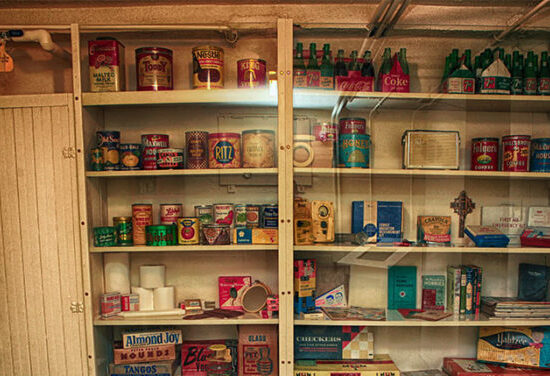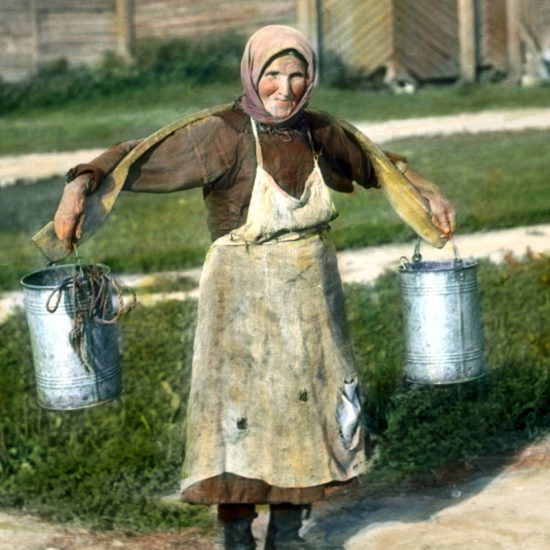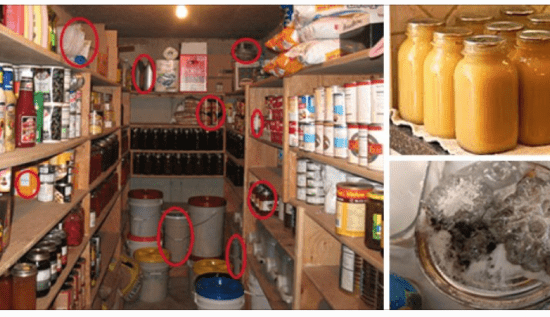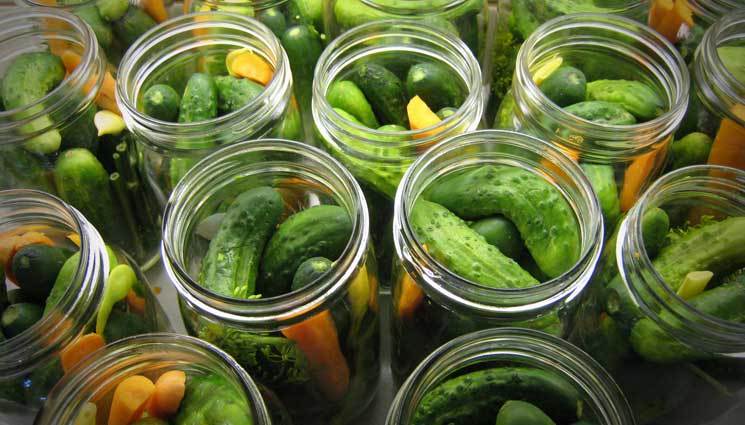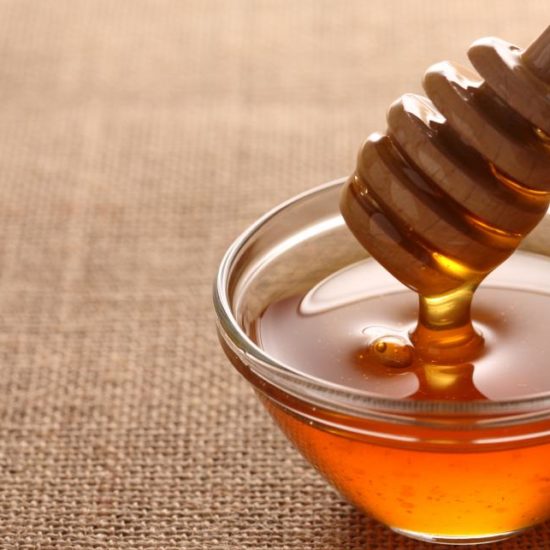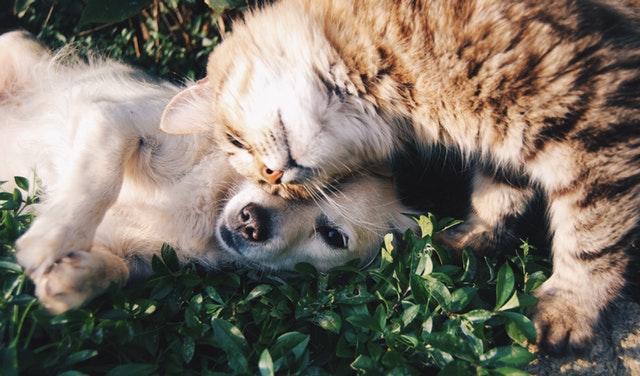
Dogs and cats are a vital part of the homestead or when your prepper nightmare come true. Whether you plan to bug out or bug in, your pet may play an important role as a protector for you family, or a great alarm system, in addition to being loving companions.
They provide much needed pest control, if you’ve got a good mouser on your hands. A dog can provide great livestock protection, and help with hunting and tracking. They can also help keep rabbits, moles and other small game away from your garden.
Feeding your pets from a prepping prospective, or just trying to find a free way to feed your animals presents some questions.
How do you know what your animals need? How do you acquire their food? What’s safe for them? And what does all this knowledge actually look like in your pet’s food bowl?
Check it out.
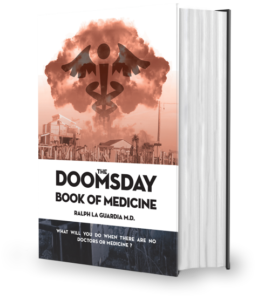
Want to learn how to grow nutrient dense foods that will nourish your mind and body? Discover more here.
Dietary Needs of Dogs and Cats
You may think dogs are the most carnivorous of the two, but in fact, felines need more protein in their diet than canines. Carbohydrates however, are not a necessary addition in your cat’s diet. Cats are carnivores first and foremost. Healthy, adult Cats may only need 5-10% carbs, usually obtained through ingesting animal protein, for reference, a mouse carcass is about 3% carbohydrates. They need 30-50% fat, and 50-60% protein. Of course, your cats’ specific need vary based on their life stages and activity level.
There is some debate on what exactly is the perfect ratio of protein, fats, and carbs for canines. Part of that is because there are so many different breeds with varying sizes and body types. Also, because there are still ongoing discussions about whether dogs are omnivores or carnivores. Nevertheless, dog food companies create “well balanced” food for canines by the thousands of pounds for us to buy and feed to our furry family members.
Here’s what we do know and some general guidelines to abide by. An adult dog may only need 18-25% protein in their diet. Athletic dogs, like sled dogs, puppies, or working dog in a bug out situation, may need more protein. A dog’s diet can contain 30-70% carbohydrates, and 10-15% fat. These percentages will change throughout your dog’s lifespan and with different activity levels.
Make sure the meals you make for your pet meet its individual and breed specific needs. It is important to make sure cats get enough of their food from animal products. There are many vitamins, minerals, amino acids, and fatty acids that cats can only get from animal proteins. In contrast, dogs have the ability make up for some of these needs by converting pre-vitamins into the vitamins they need. A dog can thrive with high levels of carbohydrates where cats lack the enzymes to break them down and absorb their nutrients.
Another important factor to consider is your animals water intake. Even if you’re feeding them a perfectly balanced diet, without proper water consumption your pets body won’t be able to carry important nutrients into cells of the body. Water also helps the body maintain a normal body temperature. Without it, organs will begin to fail and the body will start to shut down.
Cats naturally have a low thirst drive, and even if they’re supplied with a fancy water fountain, they don’t make that deficit up by themselves. Store bought kibble usually contains only 5-10% water, by making your own food at home you can take control of some of that water consumption by adding it to their food.

Want to learn about essential health practices, the right way to take vitamins, and why they currently aren’t working for you? Details HERE.
Food/Herbs to Avoid
Not everything in your garden is safe for everyone on the homestead. Feeding toxic foods on the homestead could be a costly mistake, even worse if you’re relying on your dog after the end of the world as we know it. Here are just some of the things commonly found on the homestead or in a bug out bag that are hazardous to your pet:
- Coffee and caffeine can cause gastric upset and if enough is consumed can cause seizures or death.
- Garlic, Onions and Chives can cause gastro intestinal irritation. Onions are the most toxic to cats.
- Raisins and grapes can cause kidney failure for unknown reasons.
- Milk and Dairy can cause digestive upset because pets can’t break down the lactose in those foods.
- Nuts have high levels of fats that can cause vomiting and diarrhea. Just 6 macadamia nuts can be toxic to dogs.
- Yeast dough can cause gas in the digestive system, this could cause bloat or gastric torsion (stomach twisting) which may need surgery and is life threatening. In addition, the yeast can make ethanol as a biproduct which is the same as giving them alcohol.
- Alcohol can cause an array of problems, the worst of which are coma or death.
So, you have an idea of what providing a diet for your dog or cat can take, and what foods you may encounter that aren’t safe for them. That presents the question – Where do you get the food? As homesteaders, you probably don’t want to come up with the cash for this. How can you provide this food directly from your homestead or after the dust settles?
Look at these options:
Trading Goods/Services
Do you regularly grow too many tomatoes, have too much goat’s milk, extra wool or like me, too many eggs? Do your neighbors raise cattle while you raise goats or sheep? Make a fair meat trade to create some variety in your pet’s diet. I regularly trade my extra eggs for a basket of veggies, or groom my neighbor’s dogs in exchange for help around my homestead.
Maybe you make amazing quilts or pottery, or you even have teaching or barber skills. Get to know the owners of your local feed store, they may be willing to make a trade if you have something they need. Without the exchange of money, both parties leave feeling like they got a great deal.
The point is, if you have a skill or a good to trade for dog or cat food, DO IT! Bartering is a great way to acquire the things you need on the homestead, and will surely be an integral part of the post-apocalyptic world. Brush up on these skills and make the connections you can trust now and that you’ll need later.
Food Scraps
Maybe there’s no one you know who has extra dog food kibble, what about what you or your neighbors do have, that your grow or raise for yourself and your family. There are always extra’s when processing livestock. The extra parts your neighbors throw out, the heart, tongue, eyes, brain, and other organs, all the stuff that your kids cringe at eating. Have that meat ground or chopped, better yet do it yourself. It’ll be a great free protein to add to your pet’s diet.
Growing some safe extra’s in the garden or foraging for some wild edibles on your way to your bug out location is also a great way to nourish your pet.
Check out some of the things they can indulge on that you probably have on your homestead or can find nearby.
- Apples, pears and oranges are a great source of vitamins A and C, also Fiber. Make sure to take the core and seeds out first. And peel the orange as it is poisonous.
- Blueberries, cranberries and strawberries are vitamin rich.
- Bell peppers help boost the immune system.
- Carrots are low in calories and high in fiber.
- Sweet Potatoes and Pumpkin offer water, fiber and nutrients.
- Watermelon is high in water so is great for keeping your pet hydrated.
- Eggs can be given in moderation for added protein.
- Bones are an important source of calcium which is a must have in a dog and cats diet. They can be ground into the meat to prevent choking and splintering hazards.
The list goes on, just make sure what you’re giving your pet, either straight from the land or from your plate, hasn’t been modified with added sugars or salt that can be unhealthy for your pet.
Hunting
If you’re a skilled hunter or fisherman raking in extra for your animals means fresh dinners for everyone! Your cat will love extra salmon or whatever fish you can get locally. Just keep an eye out that you’re not feeding them fish that’s too high in mercury. Use it sparingly.
If you’re prepping for the inevitable collapse, you may want to think about making a hunting dog earn their keep. If your beagle wants to have rabbit tonight, he can help track them down and spook them out. Your bird dog will play a vital role in making sure no kill goes unfound. You may allow them to track and hunt their food on their own.
Plenty of barn cats fend for themselves by doing their job and can help keep the homestead barn a mouse and snake free place. This may wind up saving your precious eggs from thieves in the night, and keep predators away from your hens.
The Raw Dog and Cat Food Diet
Everyone has their opinions on whether feeding animals raw diets is safe. If you’re allowing your cat or dog to hunt on their own, you’ve already made the decision to allow some of these dangers around your home. If you plan to provide each ingredient for your pet’s food you may want to weigh your options with feeding raw or cooked meals.
Raw meaty bones are controversial even with pro-raw dieters. Some say no whole bone is a safe option for dogs. Others believe that if you’re giving a large meaty beef bone, preferably after a meal, there can be great advantages. Steer clear of poultry and pork bones as they can splinter too easily.
A bone can be a great after dinner treat as long as its longer than the length of the muzzle, and you supervise your dog to make sure no chunks of bone are breaking off. Refrigerate the bone between uses, as it probably still has traces of meat on it, and discard it after a few days of use.
There are both advantages and dangers and associated with the Raw diet. You should always ask your trusted veterinarian their opinion with regards to your pet’s ideal diet. Ask them about what a raw food diet should look like for your pet’s specific needs. They may suggest adding supplements like calcium if you don’t plan to use bones, fish oils for omega 3s and fatty acids, or cod fish oil for DHA.
Like any new food, start out slow to allow your pets body time to adjust. Remember it’s not all or nothing, half raw, half cooked is always an option if raw meat isn’t for you.
Some advantages to the raw diet include:
- Avoiding Pet Food Recalls – Food recalls that have been recently circulating the mainstream media. When a recall occurs, your pet may have already been exposed to something harmful. Homemade and locally sourced food limits this danger.
- Oral Health – Better oral health is associated with the raw diet because it requires your pet to tear and chomp on raw meat and bones, creating a flossing and scrubbing action that keeps teeth and gums clean.
- Weight Maintenance- Because of the higher amount of protein in the raw food diet, a lot of pets lose fat and maintain muscle mass.
- Muscle Strength – Because of all the work put into chewing and tearing meat from bones, your pets neck, jaws, shoulders and back muscles may strengthen.
- Better Digestion and Improved stool quality are also associated with the raw diet.
- Organic Options- Depending on where you get your products, the diet you provide can be free of pesticides and harmful chemicals. Not to mention added hormones you could find in beef and poultry products.
Disadvantages of the raw diet are:
- Some dog cannot process raw foods due to their level of activity. If your dog is less active, you should feed them less meat.
- Risk of infectious diseases- Salmonella and E. coli are just some of the infectious diseases that you and your pet could come into contact with while ingesting the raw diet. There is also a risk of shedding these diseases to other pets or people once infected.
- Nutritional Risks – By not adding enough variety, starting puppies out on a raw diet to early, or making sure you pet is getting the nutrients it needs from animal protein you could risk a nutrient deficiency occurring.
- Some view the risks of allowing a pet to have meaty bones too great to enjoy the benefits like improved oral health and better breath.
Whether you’re planning to keep your pets with you when SHTF or you’re planning to take the next step in self-sufficient homesteading, learning what your canine or feline friends needs out of their diet and avoiding harmful or toxic products is the first step in providing homemade pet food. Deciding where and how you’ll source your ingredients is essential to creating the raw pet food diet or cooked from scratch recipe’s your pets will love.
Does all this information make your head spin? Do you want to know what to include in your pet’s bowl? Check out some tried and true recipes to get some ideas about what a complete meal looks like and what your pet might enjoy for dinner.
Cat Friendly Recipes
Rice and Chicken recipe
Ingredients–
½ pound pulled chicken
1 large hard-boiled egg
¼ cup rice
4 teaspoons olive oil
1 cup chicken stock
Directions:
Finely chop the boiled egg. Place all ingredients into a saucepan, bring to the boil. When the stock is boiling, reduce the heat and simmer until the liquid cooks down. The rice will absorb most of the liquid. Remove cat food mixture from the heat and allow it to cool. Blend the mixture in a food processor or use an emulsion blender until all the ingredients are well blended and serve.
Beef and Oats Recipe:
1-pound ground beef
1 cup rolled oats
2-3 spinach leaves
3 cups water
1 hard-boiled egg
2 tablespoons vegetable oil
Boil the rolled oats in water until they become very soft and begin to absorb the water. Next, Boil an egg. When it’s cool enough, remove the eggshell and the chop the egg. Add egg into the oats. Chop spinach. If you don’t want it raw, in a fry pan, add the oil and beef and cook thoroughly. Add the beef into the oat and egg mixture and stir in spinach. Finally, mix the ingredients together well.
Dog recipes:
Ground Turkey and veggies:
Ingredients
3 pounds ground or shredded turkey
1 zucchini
1 ½ cups brown rice
3 cups baby spinach
2 carrots
½ cup peas
1 tablespoon olive oil
Directions
In a large saucepan with 3 cups water, cook rice. Heat olive oil in a large stockpot over medium heat. Next add ground turkey and cook until browned. Leftover pulled turkey would work great also. Chop or shred carrots, zucchini and spinach. Finally, stir in spinach, carrots, zucchini, peas and brown rice until the spinach has wilted and the mixture is heated through, and let cool completely.
Beef Stew Recipe:
Ingredients–
1 pound of beef chunks
½ cup of flour
½ cup of green beans
1 small sweet potato
½ cup of carrots, diced
½ cup of water or organic vegetable oil,
1 tablespoon of oil of choice for frying
Directions
Bake a sweet potato until its tender, it still needs to be a little firm. Cut stew pieces into desired size chunks based on the size of your dog. Cook the beef chunks in cooking oil until cooked through. Remove the beef chunks from the pan, but don’t forget to save the juices for later.
Cut the sweet potato into small pieces. On low, heat up the leftover beef drippings. Add flour a little at a time to create a thick gravy, keep whisking. Add as much water or oil as needed to the gravy. Add the beef, sweet potato, carrots and green beans into the gravy and stir to coat. Let simmer until carrots are cooked through.
Treats:
There’s always room for treats in our house! Some raw veggies, like carrots, peas, and green beans make great treats for your dogs. Your cat may enjoy something steamed like, asparagus, broccoli or celery. If you want to spoil them with a more complex treat option, check out these recipe’s below:
Bacon Biscuits
This is a great way to give your pets a little taste of yummy bacon, without ruining their waistline.
Ingredients:
1/2-lb pastured bacon
3 cups whole grain flour
1 egg
1 cup water or stock
Directions:
Cook the bacon in a pan or bake it in the oven until crispy. Chop the bacon into desired size pieces. Add in all other ingredients. You can add more flour or whichever liquid you chose if needed to make this a semi-hard dough. Add balls of dough to a cookie sheet. You can make large or small biscuits depending on the size of your dog. Flatten to desired thickness, and bake until done.
Dried Liver Treats
These are super lean and healthy for both cats and dogs. First pan fry beef liver in olive oil over low heat until cooked through. Let it cool enough so you can handle it, and slice it to desired thickness. Smaller for cats, bigger for your large breed dog. Spread cooked slices on a baking sheet and slow bake in the oven at 200 degrees F. Turn the slices over after two to three hours until they are dry and crispy.
Catnip Toy
Grab an old sock that you don’t use anymore (a child’s sock works great) or if your crafty you can knit your own little mouse or ball. Just add in a handful of dried catnip, and knot the ankle for hours of free feline intoxication. To make your own dried catnip, just hang a small bunch upside down in a window until dry. Crumble off the leaves in a bag or jar to keep.
What’s your pet’s favorite food? Let us know in the comments section below.
Other self-sufficiency and preparedness solutions recommended for you:
The Lost Ways (The vital self-sufficiency lessons our great grand-fathers left us)
Survival MD (Knowledge to survive any medical crisis situation)
Backyard Liberty (Liberal’s hidden agenda: more than just your guns…)
Alive After the Fall (Build yourself the only unlimited water source you’ll ever need)
The Lost ways II (4 Important Forgotten Skills used by our Ancestors that can help you in any crisis)
The Patriot Privacy Kit (Secure your privacy in just 10 simple steps)















